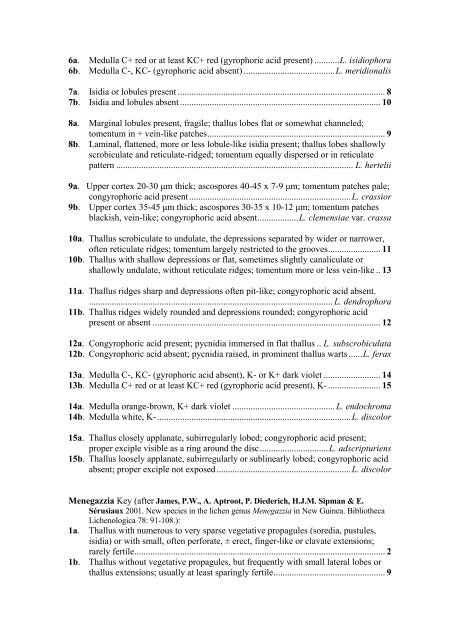Keys to the macrolichens and checklist of the lichens and ...
Keys to the macrolichens and checklist of the lichens and ...
Keys to the macrolichens and checklist of the lichens and ...
Create successful ePaper yourself
Turn your PDF publications into a flip-book with our unique Google optimized e-Paper software.
6a. Medulla C+ red or at least KC+ red (gyrophoric acid present) ...........L. isidiophora<br />
6b. Medulla C-, KC- (gyrophoric acid absent) ........................................L. meridionalis<br />
7a. Isidia or lobules present ........................................................................................... 8<br />
7b. Isidia <strong>and</strong> lobules absent ........................................................................................ 10<br />
8a. Marginal lobules present, fragile; thallus lobes flat or somewhat channeled;<br />
<strong>to</strong>mentum in + vein-like patches.............................................................................. 9<br />
8b. Laminal, flattened, more or less lobule-like isidia present; thallus lobes shallowly<br />
scrobiculate <strong>and</strong> reticulate-ridged; <strong>to</strong>mentum equally dispersed or in reticulate<br />
pattern ........................................................................................................ L. hertelii<br />
9a. Upper cortex 20-30 μm thick; ascospores 40-45 x 7-9 μm; <strong>to</strong>mentum patches pale;<br />
congyrophoric acid present.......................................................................L. crassior<br />
9b. Upper cortex 35-45 μm thick; ascospores 30-35 x 10-12 μm; <strong>to</strong>mentum patches<br />
blackish, vein-like; congyrophoric acid absent..................L. clemensiae var. crassa<br />
10a. Thallus scrobiculate <strong>to</strong> undulate, <strong>the</strong> depressions separated by wider or narrower,<br />
<strong>of</strong>ten reticulate ridges; <strong>to</strong>mentum largely restricted <strong>to</strong> <strong>the</strong> grooves....................... 11<br />
10b. Thallus with shallow depressions or flat, sometimes slightly canaliculate or<br />
shallowly undulate, without reticulate ridges; <strong>to</strong>mentum more or less vein-like .. 13<br />
11a. Thallus ridges sharp <strong>and</strong> depressions <strong>of</strong>ten pit-like; congyrophoric acid absent.<br />
........................................................................................................... L. dendrophora<br />
11b. Thallus ridges widely rounded <strong>and</strong> depressions rounded; congyrophoric acid<br />
present or absent .................................................................................................... 12<br />
12a. Congyrophoric acid present; pycnidia immersed in flat thallus .. L. subscrobiculata<br />
12b. Congyrophoric acid absent; pycnidia raised, in prominent thallus warts ......L. ferax<br />
13a. Medulla C-, KC- (gyrophoric acid absent), K- or K+ dark violet ......................... 14<br />
13b. Medulla C+ red or at least KC+ red (gyrophoric acid present), K- ....................... 15<br />
14a. Medulla orange-brown, K+ dark violet ............................................. L. endochroma<br />
14b. Medulla white, K- .....................................................................................L. discolor<br />
15a. Thallus closely applanate, subirregularly lobed; congyrophoric acid present;<br />
proper exciple visible as a ring around <strong>the</strong> disc..............................L. adscripturiens<br />
15b. Thallus loosely applanate, subirregularly or sublinearly lobed; congyrophoric acid<br />
absent; proper exciple not exposed...........................................................L. discolor<br />
Menegazzia Key (after James, P.W., A. Aptroot, P. Diederich, H.J.M. Sipman & E.<br />
Sérusiaux 2001. New species in <strong>the</strong> lichen genus Menegazzia in New Guinea. Biblio<strong>the</strong>ca<br />
Lichenologica 78: 91-108.):<br />
1a. Thallus with numerous <strong>to</strong> very sparse vegetative propagules (soredia, pustules,<br />
isidia) or with small, <strong>of</strong>ten perforate, ± erect, finger-like or clavate extensions;<br />
rarely fertile.............................................................................................................. 2<br />
1b. Thallus without vegetative propagules, but frequently with small lateral lobes or<br />
thallus extensions; usually at least sparingly fertile................................................. 9




